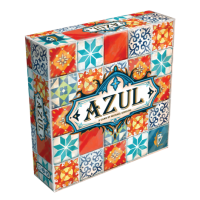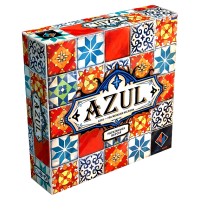Аzul Board Game Review
Related Products
PAVE YOUR WAY TO VICTORY
This wonderful tile-laying game created by Michael Kiesling has taken the world by storm. Read our Azul review to find out why this Spiel des Jahres -nominated game keeps people talking about it so much!
Originally blue and white, but later made in many bright colors, azulejo tiles have been around for a very long time. The beginning of these functional works of art dates back to the 13th century. Originally Moorish in origin, the art form really took off when King Manuel I of Portugal visited Spain in 1503. While there, he was mesmerized by the gorgeous tiling that covered almost every visible surface. Enchanted and inspired, upon his return he ordered the production of Portuguese azulejos.
In Azul, you take on the role of one of the commissioned artists. Your goal is to decorate the estate with azulejo tiles (i.e. score the most points) before the end of the game to please the king. After all, the king's mercy is worth its weight in gold.

SO LET'S START THE REVIEW)
During each round in Azul, players will take turns building tiles from multiple collections of tiles in the center of the table. The tiles a player chooses directly affect the pool of tiles left for other players to choose from. After taking all the tiles of the same color from one of the factories, the player will place those tiles on the "pattern line" section of his board according to certain placement rules. Once all the tiles have been stacked, any completed lines of the pattern will result in the tiles being added to the "wall" area of the player's tablet and points will be awarded. The game continues in this manner until one player has completed a horizontal line of tiles on their wall. A final tally is then made and the player with the most points wins.
If you're just wondering what we think of the game, feel free to scroll down to the Opinions section of this review. However, if you want to know more about the game, read on.
PREPARATION FOR WORK
First, each player takes a game tablet and places it in front of him and places his cube on division 0 of the victory point track:
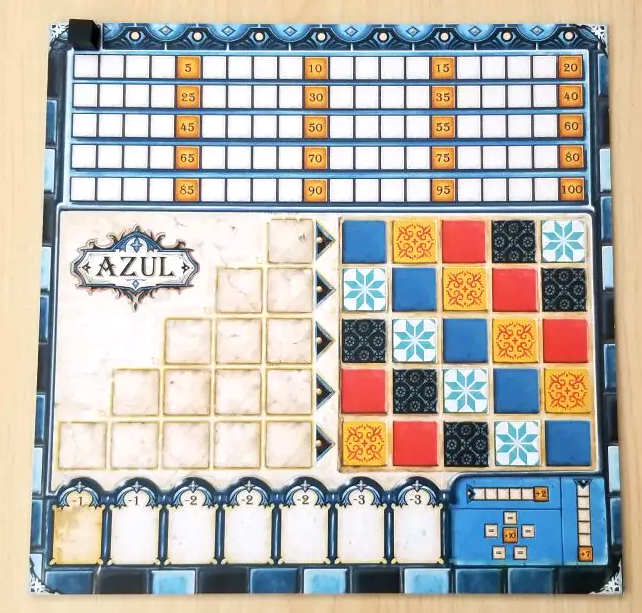
Then several "factory tokens" (depending on the number of players) are placed in the center of the table in a ring. These Factories are then replenished with 4 tile tiles drawn from the bag:
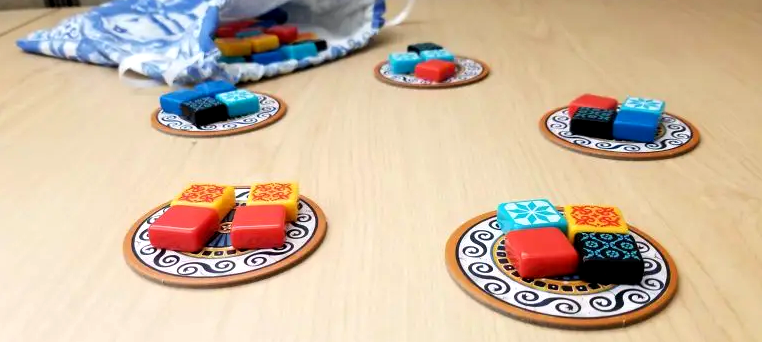
The first player is selected and receives the corresponding tile of the first turn:
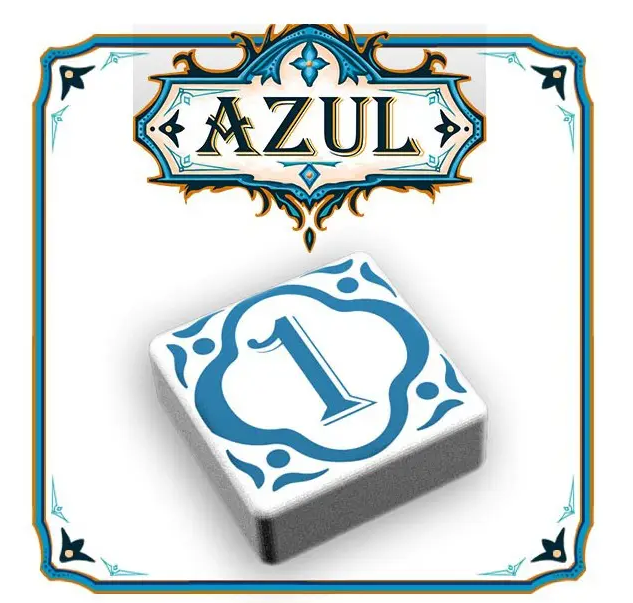
Now you are ready to play.
WE BEGIN TO FORM OUR PATTERNS
At the core of Azul is the tile selection that takes place each round. Before the first player begins his turn, the player's starting tile is placed in the center of the factory circle, and the first player places 4 tiles per factory. On his turn, the player chooses a group of tiles from any factory, takes all tiles of the same color and places them on his board in the pattern line area. All unselected tiles are moved to the central area between factories. Alternatively, a player may take all tiles of the same color or pattern from the center area, but if a player's starting token is present, they must also take it and immediately add it to the "floor line" area on their board (more on that later).
Placing tiles on a pattern line requires players to follow some basic rules:
- All tiles on the same line must be of the same type.
- A player cannot place tiles on a pattern line if the wall row corresponding to that pattern line already contains tiles of that color.
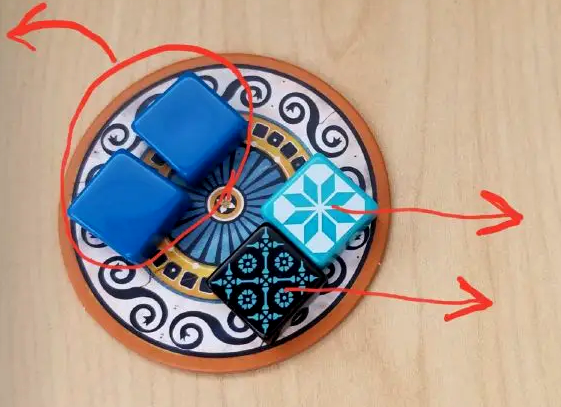
WE TAKE A BREAK AND COUNT THE POINTS
After all the tiles have been taken from the factories (any tiles that cannot be used by the players are placed on the floor line), each line of the pattern is examined from top to bottom. For each completed pattern line, the rightmost tile is moved from the pattern line to its corresponding location on the wall. Tiles remaining on a completed pattern line are removed from the player's board and returned to the box for a specified time.
Each tile placed on the wall is counted both vertically and horizontally. A tile alone is worth one point. However, if that tile completes a line of tiles, it gets points for each tile in that line. To better illustrate this, consider an example.
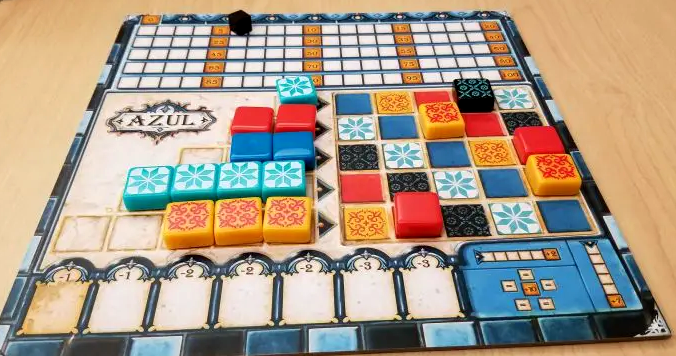
In the above example, there are several finished pattern lines - line 1, line 2 and line 4. Lines 3 and 5 are incomplete. Pattern line 1 consists of a single tile in a classic blue and white azulejo style. Since this line is complete, the tile is placed in the corresponding location on wall line 1. There is already a black tile on wall line 1, and since this newly placed tile touches the black tile, the player will receive 2 points. There is currently nothing in wall line 2, so the newly placed tile will not score vertically.
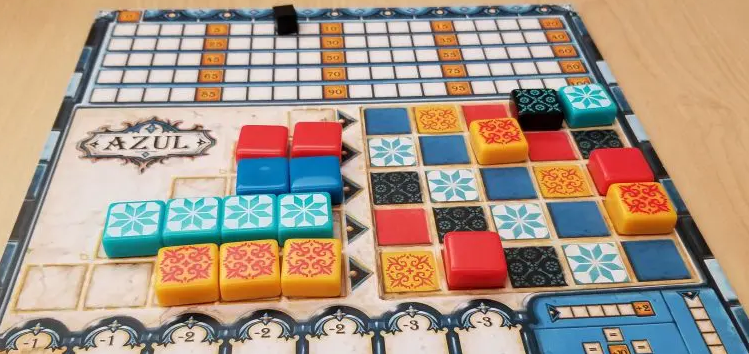
The second line of the pattern contains two red tiles. As this line is completed, one of the red tiles is moved to its corresponding location on the line of Wall 2. The remaining red tile is placed back into the box. Since there is already a yellow tile on the Wall 2 line, this newly placed tile will score points for both itself and the yellow tile. And, because of the black tile above the newly placed tile, it will also get a point for itself again, just like the black tile. As a result, the player gains 4 more points.

Row 3 is incomplete, so those tiles remain where they are. Ditto for pattern line 5. As pattern line 4 is completed, one of the tiles from there is moved to wall line 4, where it receives the corresponding points. The other tiles in pattern row 4 are placed back into the box.
Finally, after scoring points for each pattern line completed, players look at their floor line. Any tile will give players negative points. The more tiles in that area, the more negative points they get.
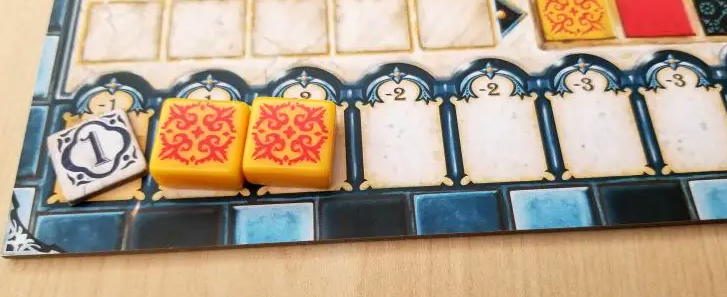
After all players have finished scoring, any tiles on their floor lines are placed back into the box. The player with the first player's tile places it back in the center area and then fills the bag factories with new tiles. If the bag runs out of tiles, it is replenished with tiles from the box.
THE WORK IS FINISHED, THE FINAL POINTS CAN BE CALCULATED
Play continues in this manner until the end of a round in which at least one player completes one horizontal line of the wall. Then the final scoring is done. Players earn bonus points for completing wall lines, vertical rows, and collecting all 5 items of the same color. After the final tally is completed, the player with the highest number of points is declared the winner.
NOW FOR OUR IMPRESSIONS AND THOUGHTS ABOUT THE GAME
Azul is very attractive at first with its design and excellent components. The colors are bold and bright, and the tiles have a pleasant massiveness and tactility. It's just a very attractive game. Looking at it, we can totally understand the obsession of King Manuel I. Kudos to Chris Quilliams and everyone else involved in the visual aesthetics of this game.
When we first saw Azul on the table, we sat down to play knowing nothing about the game other than its popularity. To be honest, we didn't know what to expect. When we read the rules, they were pretty easy to understand and we couldn't wait to start playing once the rules were explained.
The first game didn't go very well. By the end of the fifth or sixth round, one of the players managed to earn only 17 points. In the very next round, the player was stuck with a huge pile of red tiles, which all went to his floor. In one fell swoop, almost all of his progress was wiped out. We were a little disappointed and ready to throw Azul into the fire and never return to it.
Fortunately, cool heads prevailed. We still convinced ourselves to come back and try the game. Our terrible experience with the first game taught us lessons we didn't even realize. To repeat a banal expression, it's as if a light bulb has gone out in our heads. Suddenly, we were able to look at the mechanics of the game and see the smart strategy behind it. Going from Azul's number one detractor to one of his biggest fans.
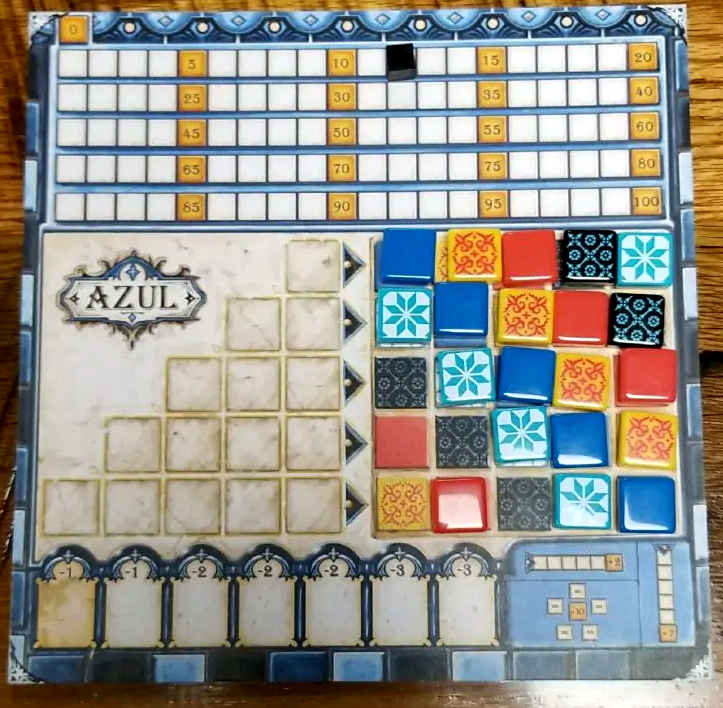
Playing Azul is very similar to playing chess. You should always be aware of what your opponent is doing. Sometimes it's very obvious, sometimes less so. If you can clearly see that their execution of one pattern line will earn them a ton of points, then your strategy should change accordingly. You may want to try to send as many tiles of that color to the center as possible so that they are forced to take more than they need. Or maybe you decide to try to collect all those tiles for yourself. However, if you go this route, you'll want to try to maximize your scoring opportunities accordingly. It's a clever game of cat-and-mouse as you try to force your opponents into undesirable positions while trying to force them to open up good scoring opportunities for you.
This is where the essence of Azul lies - the constant guessing and re-guessing (and even triple or quadruple guessing!) as you try to figure out how your opponents might react to your actions. “If I take those tiles, they'll probably go to the ones over there, which will leave THOSE other tiles in the center, and then I can grab them next turn and complete this pattern line here. But, if they don't go for those other tiles, they can choose that group instead. Maybe I should take that other group, even if it doesn't help me much, to try to get them to go to the tiles I really want them to take. But, wait…” And it goes on. While these types of mental gymnastics may not appeal to some, for us they really make this game great. The constant need to make interesting decisions even helps to overlook randomness when displaying tiles. I almost don't notice it anymore. I'm all about getting the brain on fire.
No wonder this amazing game received a nomination for Spiel des Jahres. In a few short months, it became our second most played game. Easy-to-learn rules, super-fast set-up, and thought-provoking gameplay that keeps you coming back for more. Add to that the fact that a typical game of Azul only lasts 20-30 minutes and you have a recipe for a near perfect game. If you've never played Azul or don't know about it, we highly recommend you give it a try.
VIDEO REVIEWS

